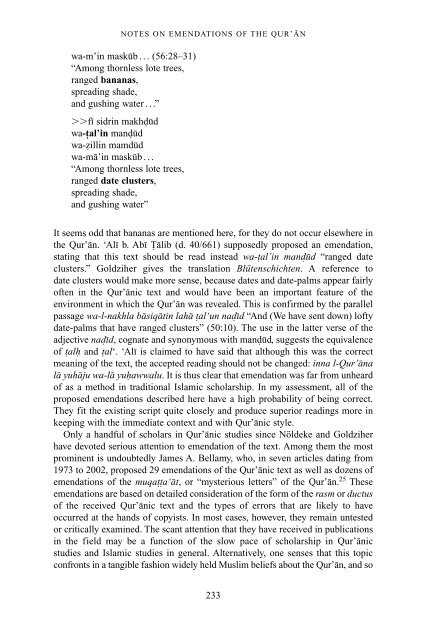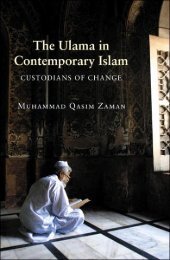The Qur'an in its historical context (pdf - Islam and Christian-Muslim ...
The Qur'an in its historical context (pdf - Islam and Christian-Muslim ...
The Qur'an in its historical context (pdf - Islam and Christian-Muslim ...
You also want an ePaper? Increase the reach of your titles
YUMPU automatically turns print PDFs into web optimized ePapers that Google loves.
NOTES ON EMENDATIONS OF THE QUR’AN<br />
wa-m’<strong>in</strong> maskub... (56:28–31)<br />
“Among thornless lote trees,<br />
ranged bananas,<br />
spread<strong>in</strong>g shade,<br />
<strong>and</strong> gush<strong>in</strong>g water...”<br />
��fi sidr<strong>in</strong> makhdud<br />
wa-tal’<strong>in</strong> m<strong>and</strong>ud<br />
wa-zill<strong>in</strong> mamdud<br />
wa-ma’<strong>in</strong> maskub...<br />
“Among thornless lote trees,<br />
ranged date clusters,<br />
spread<strong>in</strong>g shade,<br />
<strong>and</strong> gush<strong>in</strong>g water”<br />
It seems odd that bananas are mentioned here, for they do not occur elsewhere <strong>in</strong><br />
the Qur’an. ‘Ali b. Abi Talib (d. 40/661) supposedly proposed an emendation,<br />
stat<strong>in</strong>g that this text should be read <strong>in</strong>stead wa-tal’<strong>in</strong> m<strong>and</strong>ud “ranged date<br />
clusters.” Goldziher gives the translation Blütenschichten. A reference to<br />
date clusters would make more sense, because dates <strong>and</strong> date-palms appear fairly<br />
often <strong>in</strong> the Qur’anic text <strong>and</strong> would have been an important feature of the<br />
environment <strong>in</strong> which the Qur’an was revealed. This is confirmed by the parallel<br />
passage wa-l-nakhla basiqat<strong>in</strong> lahatal‘un nadid “And (We have sent down) lofty<br />
date-palms that have ranged clusters” (50:10). <strong>The</strong> use <strong>in</strong> the latter verse of the<br />
adjective nadid, cognate <strong>and</strong> synonymous with m<strong>and</strong>ud, suggests the equivalence<br />
of talh <strong>and</strong> tal‘. ‘Ali is claimed to have said that although this was the correct<br />
mean<strong>in</strong>g of the text, the accepted read<strong>in</strong>g should not be changed: <strong>in</strong>na l-Qur’ana<br />
la yuhaju wa-la yuhawwalu. It is thus clear that emendation was far from unheard<br />
of as a method <strong>in</strong> traditional <strong>Islam</strong>ic scholarship. In my assessment, all of the<br />
proposed emendations described here have a high probability of be<strong>in</strong>g correct.<br />
<strong>The</strong>y fit the exist<strong>in</strong>g script quite closely <strong>and</strong> produce superior read<strong>in</strong>gs more <strong>in</strong><br />
keep<strong>in</strong>g with the immediate <strong>context</strong> <strong>and</strong> with Qur’anic style.<br />
Only a h<strong>and</strong>ful of scholars <strong>in</strong> Qur’anic studies s<strong>in</strong>ce Nöldeke <strong>and</strong> Goldziher<br />
have devoted serious attention to emendation of the text. Among them the most<br />
prom<strong>in</strong>ent is undoubtedly James A. Bellamy, who, <strong>in</strong> seven articles dat<strong>in</strong>g from<br />
1973 to 2002, proposed 29 emendations of the Qur’anic text as well as dozens of<br />
emendations of the muqatta‘at, or “mysterious letters” of the Qur’an. 25 <strong>The</strong>se<br />
emendations are based on detailed consideration of the form of the rasm or ductus<br />
of the received Qur’anic text <strong>and</strong> the types of errors that are likely to have<br />
occurred at the h<strong>and</strong>s of copyists. In most cases, however, they rema<strong>in</strong> untested<br />
or critically exam<strong>in</strong>ed. <strong>The</strong> scant attention that they have received <strong>in</strong> publications<br />
<strong>in</strong> the field may be a function of the slow pace of scholarship <strong>in</strong> Qur’anic<br />
studies <strong>and</strong> <strong>Islam</strong>ic studies <strong>in</strong> general. Alternatively, one senses that this topic<br />
confronts <strong>in</strong> a tangible fashion widely held <strong>Muslim</strong> beliefs about the Qur’an, <strong>and</strong> so<br />
233



